Center for Community Support and Development Studies, Real-Time Analytics and United Nations Development Program
 |
| Photo: VNA |
Introduction
This article reveals how local governments from provincial to commune levels performed in 2023 and suggests gaps to be narrowed down to better respond to citizens’ needs and expectations. It is an excerpt from the 15th edition of the Provincial Governance and Public Administration Performance Index (PAPI) Report,[1] and a follow-up on the article revealing the national overview of governance and public administration issued in Vietnam Law and Legal Forum magazine in April.[2]
This article presents key findings regarding provincial performance in eight dimensions that comprise the PAPI as an aggregate index, including Participation at Local Levels (Dimension 1); Transparency in Local Decision-making (Dimension 2); Vertical Accountability Toward Citizens (Dimension 3); Control of Corruption in the Public Sector (Dimension 4); Public Administrative Procedures (Dimension 5); Public Service Delivery (Dimension 6); Environmental Governance (Dimension 7); and E-Governance (Dimension 8). In 2023, PAPI reflects the experiences of 19,536 respondents from across Vietnam with local government performance in governance, public administration and public service delivery as measured across the eight dimensions as well as in the aggregate PAPI scores. Where necessary, time-series perspectives of key indicators are presented to show meaningful trends over 2021 and 2023, allowing provincial governments to identify areas for improvement and strive for better performance in the coming years. The PAPI survey results have also meant to inform Vietnam’s legislative and policy agenda as well as the action plans of all 63 provincial governments.
Participation at Local Levels
Participation in political, social and economic life is a constitutional right of all Vietnamese citizens aged 18 years and above. This participation is important for citizens to exercise their democratic rights and contribute to local governance improvements. This dimension measures citizens’ awareness of their right to political participation, how they participate in elections and local decision-making, as well as how local governments facilitate citizens’ rights to participation in accordance with the 2022 Law on Grassroots Democracy Implementation.
Overall, as presented in Figure 1, this dimension witnessed a slight decrease in performance compared to 2022, from 5.05 to 4.9 points. Compared with 2021’s findings, 24 provinces made positive changes in 2023, while eight provinces (especially Ca Mau, Dak Nong and Dong Thap) saw scores freefall. The remaining 27 provinces retained the status quo.[3]
Northern provinces, as in previous years, tended to outperform southern peers. This was headlined by the Red River Delta as well as the North Central and Central Coast region contributing the bulk of the 15 provinces in the High quartile, in contrast to 10 Mekong River Delta provinces and four Southeastern provinces in the Low quartile.
Concernedly, most provinces have more work to be done to enhance citizens’ knowledge of important policies, ensuring inclusive village head elections, and securing citizens’ participation in decision-making in local infrastructure projects. Similarly, citizens were not informed of important laws, including the 2016 Law on Access to Information and the 2018 Anti-Corruption Law. Analysis from the new question about knowledge of the 2022 Law on Grassroots Democracy Implementation reveals that between 14.23 percent and 45.97 percent of respondents across 61 provinces have heard about the law.
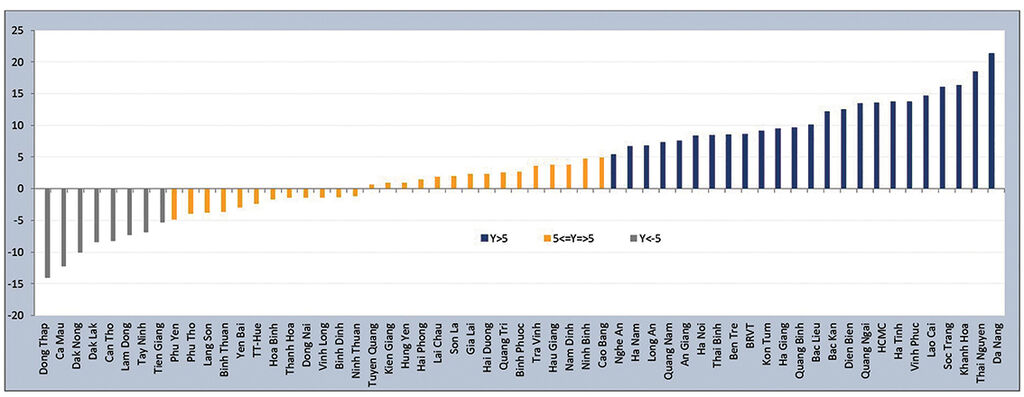 |
| Figure 1: Changes in performance in Transparency in Local Decision-making in 2023 compared to 2021 |
Regression in local governments’ performance was also evident in engaging citizens’ participation in decision-making to start or reconstruct a local project and in project implementation oversight in 2023 compared to 2021, with 45 provinces posting proportions below 50 percent, 10 provinces more than in 2021. Additionally, a significant number of local infrastructure projects did not benefit from citizens’ oversight, as the percentage of respondents noting that local Community Investment Supervision Boards were in place to monitor projects with citizens’ voluntary contributions was below 50 percent in 58 provinces, a larger number of provinces than found in 2021 and 2022.
Transparency in Local Decision-making
To understand how public policies impact citizens’ lives and livelihoods, PAPI spotlights local government efforts to facilitate access to government information and respond to civic rights. This is measured by the four sub-dimensional areas of Access to Information, Transparency of Poverty Lists (listings of poor households), Commune Budget and Expenditure Lists, and Local Land Use Planning and Pricing.
Concernedly in 2023, compared to 2021’s dimensional scores, 23 provinces saw significant year-on-year declines. All provinces scored between 4.31 points and 5.88 points on the 1-10 point scale, a notable decrease in score range compared to 2021. Some 24 provinces saw little change, while 12 made improvements in 2023.[4]
Among 16 provinces in the Low quartile, the Mekong River Delta contributed eight, with three each from the Central Highlands and Southeastern region. As with previous years, northern provinces performed more strongly than their southern counterparts, with the North Central and Central Coast, Red River Delta, and Northern Midland and Mountainous regions contributing 15 provinces to the High quartile.
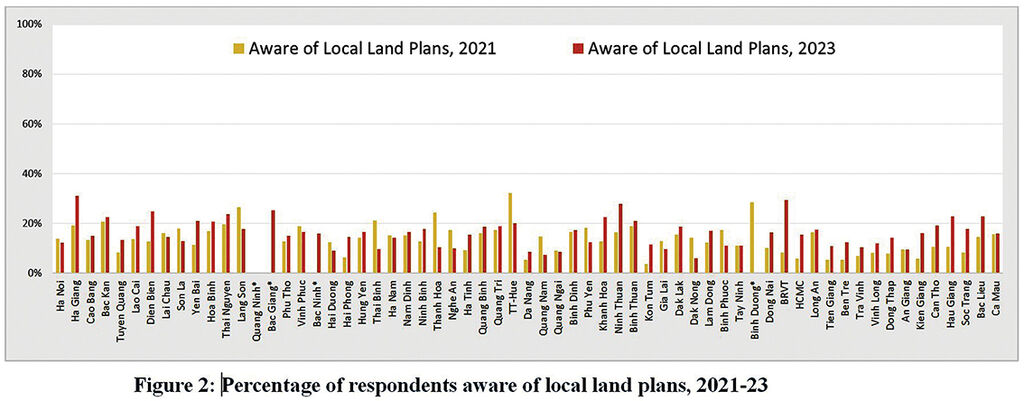 |
Key trends include Access to Information about state policy and legislation remaining the weakest of the four sub-dimensions, while Transparency of Poverty Lists saw the highest score ranges. The remaining two sub-dimensions posted lower ranges. As was the case in 2021, citizens’ access to information about local land-use plans remained limited in all provinces in 2023 (see Figure 2). However, some significant improvements (by 5 percent or more) in 21 provinces were evident in 2023 compared to 2021. Likewise, 23 provinces saw rises above 5 percent compared to 2021 in local governments posting official land price frames, important for citizens when their land is subjected to the State’s seizure.
Vertical Accountability Toward Citizens
This dimension consists of three sub-dimensions: Interaction with Local Authorities, Government’s Responsiveness to Citizen Appeals, and Access to Justice Services. These sub-dimensions reflect how local governments respond to citizen requests, proposals, denunciations, complaints and/or petitions. Interestingly, the third sub-dimension spotlights levels of trust in courts and judicial agencies, plus access to non-court mechanisms when citizens encounter civil disputes.
Overall, this dimension has become becalmed with 44 provinces seeing no improvement in scores during 2021-23 and just five (Cao Bang, Dien Bien, Lai Chau, Soc Trang and Son La) taking meaningful steps forward. Overall, better-performing provinces are concentrated in the north, particularly the Northern Midland and Mountainous and the North Central and Central Coast regions, while the Mekong River Delta is largely anchored at the bottom.
On a positive note, the Interaction with Local Authorities sub-dimension gained the healthiest scores. Notably, respondents had the highest level of confidence in village heads when requesting assistance (compared to commune government officials, People’s Council members and mass organization members). Similarly, in all 61 provinces, when encountering a civil dispute or disagreement with a local public official, citizens approached commune People’s Committee officials rather than elected representatives at commune People’s Councils (see Figure 3).
On a down note, the poorest performing aspect for all provinces in 2023 was handling citizens’ petitions and proposals, similar to 2022’s findings. Of respondents who sent complaints to their local government, less than half were satisfied with the resolution outcome. Interestingly, non-court mechanisms for civil dispute resolution have yet to gain traction, with citizens preferring local courts.
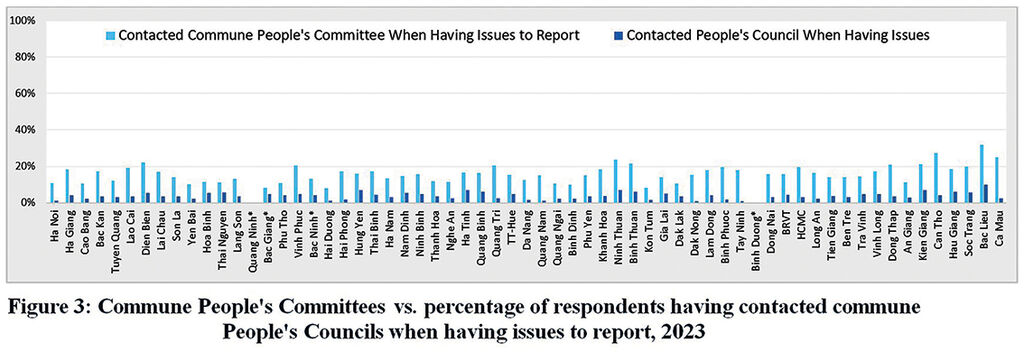 |
Control of Corruption in the Public Sector
This dimension measures public institution and local government performance in controlling corruption in the public sector. It also delivers insights into citizens’ level of tolerance for corrupt practices and willingness to curb corruption by local governments and citizens. Its four sub-dimensions are Limits on Corruption in Local Governments, Limits on Corruption in Public Service Delivery, Equity in State Employment, and Willingness to Fight Corruption.
This dimension was one of two showing improvements from 2022 to 2023. In a noteworthy change, 2023 saw more provinces from the North Central and Central Coast and Northern Midland and Mountainous regions emerge into the High quartile, while four out of five Central Highlands provinces (except Dak Lak) joined the low-performing group. Dien Bien province posted the largest growth (22.3 percent) of 12 provinces making significant progress compared to 2021, while Hai Phong (14.78 percent) headlined 19 provinces with the steepest falls of more than 5 percent.
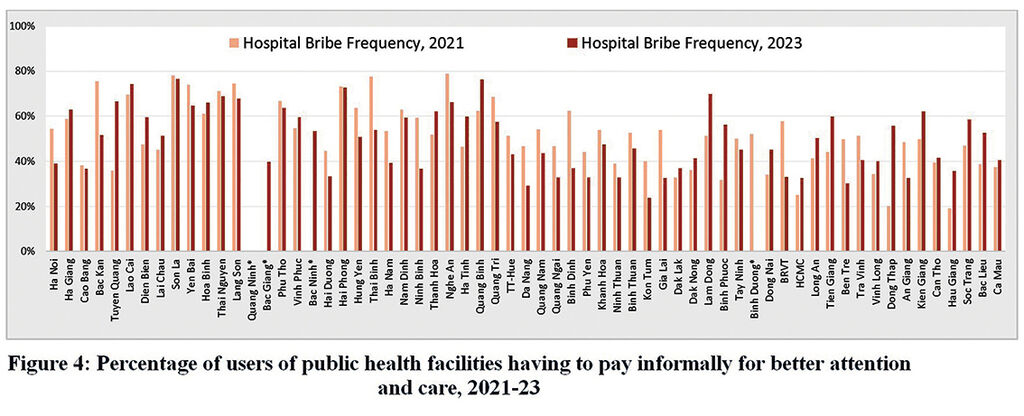 |
The weakest sub-dimension was Equity in State Employment, with much lower ranges than the other three sub-dimensions. Bribes for employment in the public sector remain common, both in poor (such as Binh Phuoc and Dak Nong) and better-off (including Hai Phong) economically developed provinces. Personal relationships remain important for five public offices at commune level (land registrars, judicial officers, police, public primary school teachers and commune People’s Committee staff) in every province. Encouragingly, the percentage of respondents paying bribes for land-use rights certificates fell in 34 provinces, with nine (Ca Mau, Cao Bang, Dien Bien, Ha Tinh, Hau Giang, Hung Yen, Soc Trang, Tay Ninh and Tuyen Quang) seeing more than 20 percent decline from 2021 to 2023. Sadly, the proportions of district public hospital users who paid a bribe in 2023 ranged from 40 to 80 percent in 40 provinces, similar to 2021 (see Figure 4).
Public Administrative Procedures
This dimension reflects the quality of public administrative services in areas important to citizens, covering three sub-dimensions: Certification Services by Local Governments, Application Procedures for Land-Use Rights Certificates (LURCs) at the District Level, and Application Procedures for Personal Documents Handled by Commune Governments. Interestingly, it spotlights the professionalism and responsiveness of government staff, from provincial to commune levels, in providing public administrative services.
While five provinces having made significant improvements during 2021-23, especially Ba Ria-Vung Tau and Tien Giang at 10.4 and 9.6 percent respectively, as many as 49 provinces posted little change. Three out of five provinces each in the Central Highlands and Southeastern regions were in the Low quartile. As with previous years, procedures and administrative services for LURCs remained more problematic than those for local government certification and personal papers. In most provinces, the lack of publicity of fees to pay for services at one-stop shops was a common problem.
Overall, regarding the total quality of public administrative services for LURCs, applicants in most provinces had varied assessments by the four criteria (i.e., fees displayed, official competent, applicants treated with respect, and deadline met). Cao Bang, Ho Chi Minh City, Quang Binh and Vinh Long had the lowest total quality scores, while Bac Lieu, Hung Yen, Ninh Thuan, Tra Vinh and Thua Thien-Hue had the highest total quality scores - but still a significant gap from the perfect score. Missing deadlines to return LURCs to applicants was a common issue, while applicants were less commonly required to engage with more officials than stipulated during the processing of paperwork in 38 provinces compared to 2021. Certification services provided by provincial to commune-level public officials were rated highly in all provinces, with a slight improvement noted in 34 provinces from 2021-23, with the increase in Ba Ria-Vung Tau most significant.
Public Service Delivery
This dimension examines local governments’ performance in delivering four public services: healthcare, primary education, basic infrastructure, and law and order. To explore this dimension, citizens are asked about their experience of the accessibility, quality and availability of these services.
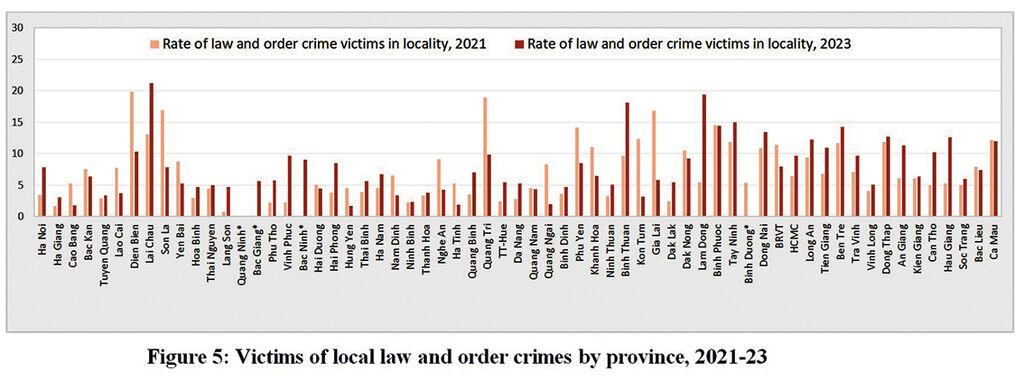 |
The Red River Delta led the way with seven out of 11 provinces in the High quartile, while the Mekong Delta region contributed seven provinces to the Low quartile. Strikingly, only Dien Bien province posted significantly higher scores in 2023 than in 2021, while 17 provinces saw large declines and 41 provinces were treading water.
Primary education witnessed the largest difference in provincial performance, with teachers’ favoritism toward students constant across all provinces (particularly Dak Lak, Hai Phong, Phu Yen, Quang Ngai and Thai Binh) and public primary school class sizes also requiring attention (particularly in Hanoi, Ho Chi Minh City, Lam Dong and Thai Binh). As in 2021, public district hospitals in all provinces were viewed as needing upgrades. Even hospital users at top-performing provinces (Ha Tinh, Hau Giang and Hoa Binh) still complained about bed-sharing, unclean restrooms, waiting times for healthcare workers, and priming of private pharmacy outlets.
The quality of roads near respondents’ homes varied greatly between poor and well-off provinces, with better ones found in the latter and sub-optimal gravel or dirt ones in the former. Cao Bang, Dien Bien, Hung Yen, Ninh Thuan and Son La upped their game compared to 2021. Garbage pick-up frequency was clearly higher in urbanized provinces than in rural ones. Law and order regressed in 36 provinces compared with 2021 due to rising victims of break-ins, robberies, thefts or physical violence. Five provinces (Binh Thuan, Hau Giang, Lai Chau, Lam Dong and Vinh Phuc) witnessed the largest jump in victims at the grassroots level in 2023 (see Figure 5).
Environmental Governance
This dimension reflects citizens’ assessment of two environmental aspects critical to their health: air and water quality. In addition, citizens were asked if they saw firms operating in their localities paying bribes to avoid compliance with environmental standards. This dimension sets baselines to assist local governments in understanding citizens’ environmental concerns over time and spotlighting environmental hotspots to be addressed.
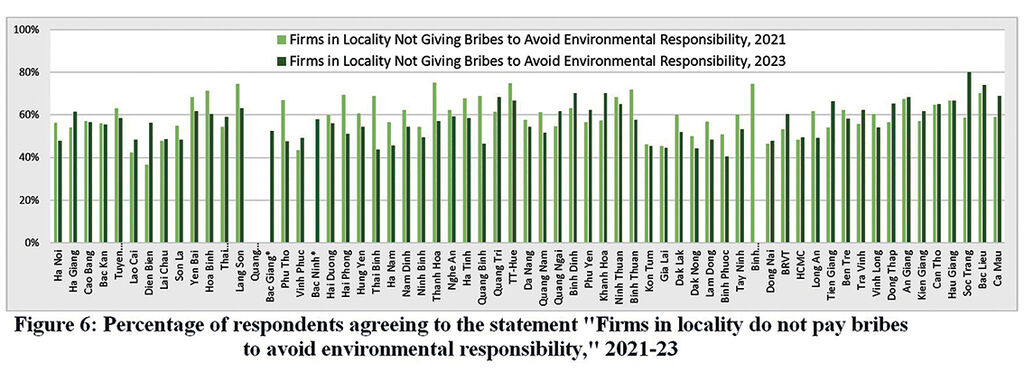 |
Hubs of environmental concern remain in the Red River Delta and Southeast regions home to industrial provinces, and the Central Highlands. Among 16 provinces in the Low quartile, six are from the Red River Delta and four each from the Southeast and Central Highlands regions. The Mekong River Delta was a bright spot with eight out of 13 provinces in the High quartile. While eight provinces (Ba Ria-Vung Tau, Bac Lieu, Dien Bien, Ha Giang, Khanh Hoa, Ninh Thuan, Soc Trang and Tra Vinh) made significant improvements during 2021-23, 26 provinces slid backward.
Local governments’ lack of commitment to environmental protection and the poor quality of domestic water sources were behind low provincial scores. As shown in Figure 6, fewer than 80 percent of respondents in all provinces agreed that firms in their localities did not pay bribes to local governments to bypass environmental regulations. More respondents in 25 provinces said their local governments responded immediately to reports of local environmental problems in 2023 compared to 2021.
E-Governance
Key aspects of e-government performance are examined in this dimension: the availability, accessibility, user-friendliness and responsiveness of online public services. This dimension provides information on the availability of local government portals for citizens to access public services and whether citizens have internet access - the enabling environment to participate in e-government. In 2023, two new indicators were introduced to start assessing the performance of provincial and national portals in providing a full suite of public administrative services.
Of note, regional patterns were more diverse in 2023, with 15 provinces in the High quartile headlined by the three centrally run municipalities of Da Nang, Hanoi and Ho Chi Minh City. Meanwhile, poorer performing provinces were concentrated in the Mekong River Delta and Central Highlands. Some 39 provinces made encouraging year-on-year improvements, while Ha Nam, Lam Dong and Nghe An saw dramatic declines from 2021.
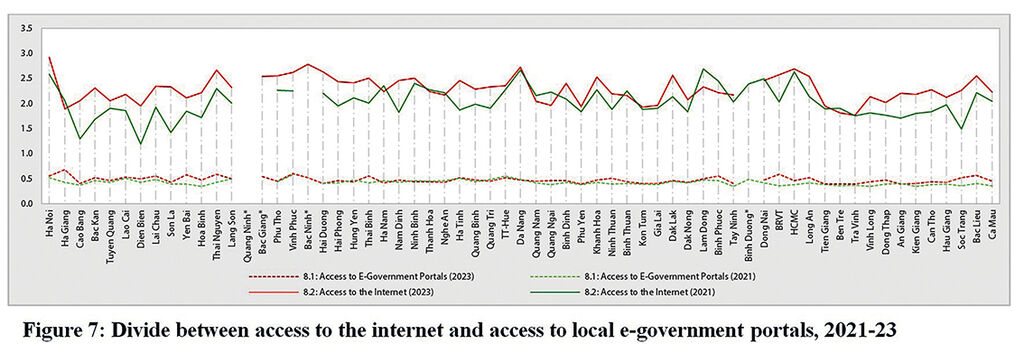 |
Citizens’ experiences in 2023 indicated a constant large divide between access to the internet and access to local e-government portals since 2021 (see Figure 7). Regarding the user-friendliness of provincial government portals, fewer than 40 percent of respondents familiar with their provincial websites in 61 provinces said the portals were user-friendly in 2023. Users in 42 provinces rated their provincial government portals as poorer in 2023 than 2021. Additionally, findings from the two new indicators (Percentage of Respondents Having Used Online Government Service Portals and Percentage of Users Being Able to Pay for Services Online) show that, in all provinces, fewer than 17 percent of respondents who performed administrative procedures in 2023 used their provinces’ online government service portals.
Aggregate 2023 PAPI scores: opportunities for improvement
This section provides an overview of aggregate performance across provinces, calculated by adding up each province’s scores in the eight PAPI dimensions. This allows provinces to assess how they perform relative to others with similar socio-economic and geographic endowments.
 |
Taking a closer look at 2023’s data, northern and central provinces tended to perform better than their southern peers (see Figure 8).[5] Of 15 provinces in the High quartile, five are from the North Central and Central Coast region and four from the Red River Delta region. Among 16 provinces in the Low quartile, seven are from the Mekong River Delta. Provincial performance did not differ greatly across provinces when considering the 2023 aggregated PAPI scores for 61 provinces. The gap between the lowest and highest possible provincial scores (38.97 points and 46.04 points, respectively) is 7.07 points. Compared to 2021’s findings, 24 provinces did significantly better in Dimension 1; 12 provinces in Dimension 2; five provinces in Dimension 3; 12 provinces in Dimension 4; and a significant 39 provinces in Dimension 8. In contrast, 19 provinces poorly performed in Dimension 4; 17 provinces in Dimension 6, and 26 provinces in Dimension 7.
Rising provincial scores in the E-Governance dimension indicate improvements in provincial performance. Other positive moves are seen in overall provincial performance in the two dimensions of Control of Corruption in the Public Sector and Public Service Delivery, with both dimensions seeing lowest provincial scores in 2023 higher than in 2021.
Conclusions and key takeaways
As this article has shown, the findings about provincial performance in each dimension and indicator that PAPI is comprised of in 2023 reveal both opportunities and challenges in satisfying citizens’ needs and expectations in terms of inclusive governance, effective public administration and efficient public service delivery. The PAPI scores at the provincial level presented in this article, and more from the 2023 PAPI Report, serve as a thermometer that gauges a province’s 2023 performance in a holistic manner and highlights gaps from the expected maximum scores for the aggregated index and the eight dimensions. Nonetheless, to understand what can be done to improve a province’s performance, provincial leaders are strongly advised to examine the findings of all indicators that make up the eight PAPI dimensions and review their performance trends over the years. More importantly, the rich information contained in more than 120 PAPI indicators[6] in the 2023 PAPI Report helps provinces prioritize their focus areas and assign responsibilities to relevant local government agencies to increase citizen satisfaction with their performances in 2024 and beyond.
As indicated in this article, there remain significant rooms for improvements in all eight dimensions. Even in E-Governance which saw remarkable improvements, a large gap between the internet access and what the local governments could offer as e-services remains in every province. Below are some action points that provincial governments should undertake in 2024 and 2025:
· Disseminate information about land use plans and land pricing frames both online and offline;
· Reduce and eliminate bribe-taking for handling land-use rights certificates;
· Reduce and control nepotism for state employment to improve the quality of public servants and thus public services;
· Provide sufficient public investment in public hospitals at the district level to increase access to basic but quality public healthcare services; and,
· Make local government portals and provincial e-service portals to be more accessible and user-friendly for increased use and for return of public investment.-
[1] The Vietnam Provincial Governance and Public Administration Performance Index (PAPI) reflects the feedback from respondents that are randomly selected to represent the views of a broad spectrum of Vietnamese citizens, aged 18 years and above, from various demographic backgrounds. Following the initial pilot in 2009 and a larger survey in 2010, the PAPI survey has been implemented nationwide each year since 2011. For more information about the PAPI research and reports, visit www.papi.org.vn.
[2] See CECODES & UNDP (April 2024). 2023 PAPI shows progress in citizen perceptions of local anti-corruption efforts and e-governance. Available at https://link.gov.vn/b7nVPrC5.
[3] Y = percentage of change in 2023 data from 2021 data, with a change of ±5% defined as statistically significant. The 2021 data from Bac Giang and Bac Ninh, and the 2023 data from Binh Duong and Quang Ninh are not included due to their manipulated extreme outlier values.
[4] The 2021 data from Bac Giang and Bac Ninh, and the 2023 data from Binh Duong and Quang Ninh are not included due to their manipulated extreme outlier values.
[5] To help provide readers and stakeholders with a visual breakdown of performance within each dimension, PAPI groups scores under four quartiles: High, Mid-High, Mid-Low and Low, with 25 percent of 63 provinces in each group. It should be noted that two provinces (Binh Duong and Quang Ninh) are not included in this Report because of their poor data integrity.
[6] 6 See findings at the indicator level for all provinces from 2011 to 2023 at https://papi.org.vn/eng/papi-data/.









